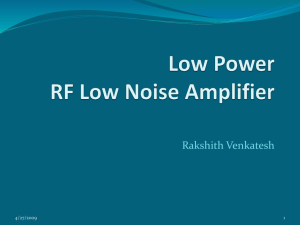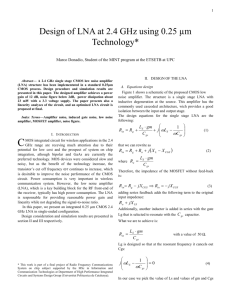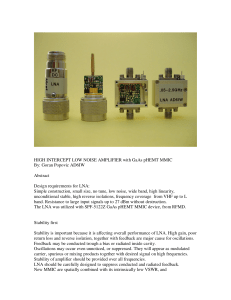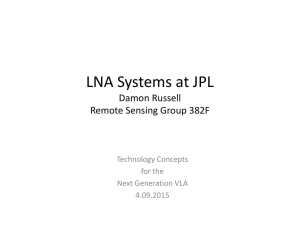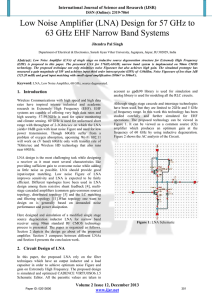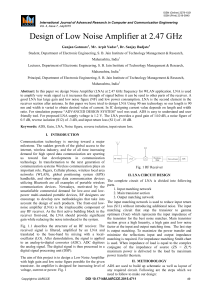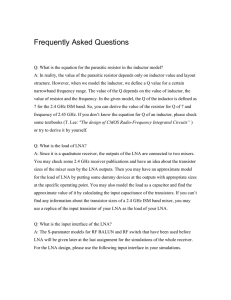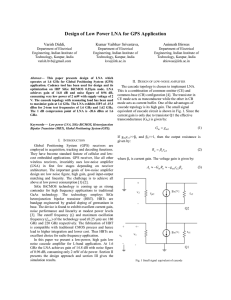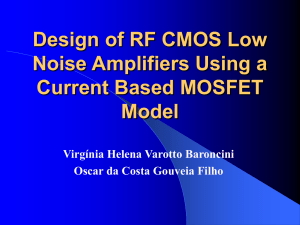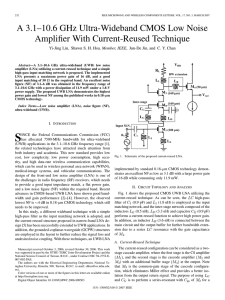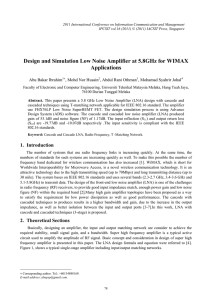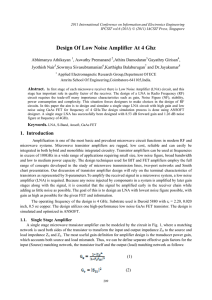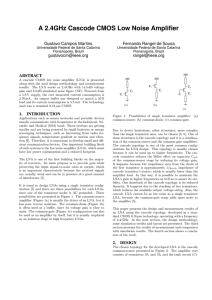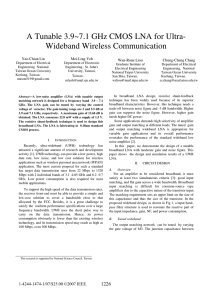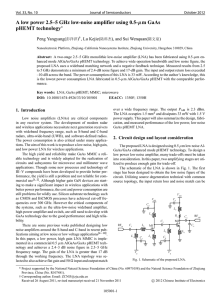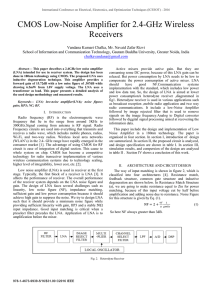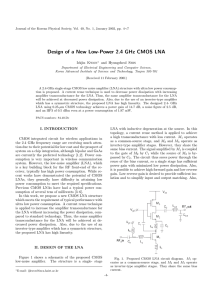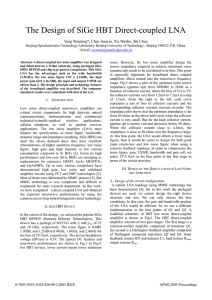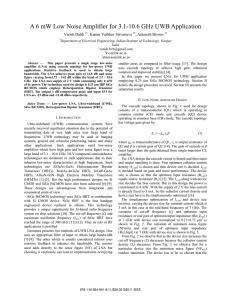By Vy-Hoa Le Smart Environments/EECS
advertisement
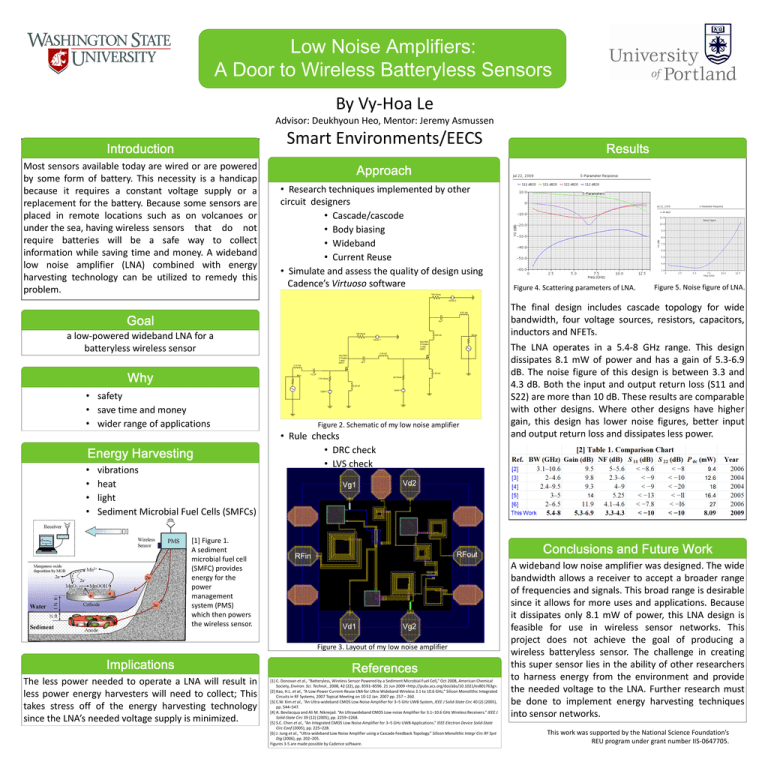
By Vy-Hoa Le Advisor: Deukhyoun Heo, Mentor: Jeremy Asmussen Smart Environments/EECS Most sensors available today are wired or are powered by some form of battery. This necessity is a handicap because it requires a constant voltage supply or a replacement for the battery. Because some sensors are placed in remote locations such as on volcanoes or under the sea, having wireless sensors that do not require batteries will be a safe way to collect information while saving time and money. A wideband low noise amplifier (LNA) combined with energy harvesting technology can be utilized to remedy this problem. • Research techniques implemented by other circuit designers • Cascade/cascode • Body biasing • Wideband • Current Reuse • Simulate and assess the quality of design using Cadence’s Virtuoso software • safety • save time and money • wider range of applications vibrations heat light Sediment Microbial Fuel Cells (SMFCs) [1] Figure 1. A sediment microbial fuel cell (SMFC) provides energy for the power management system (PMS) which then powers the wireless sensor. Figure 2. Schematic of my low noise amplifier • Rule checks • DRC check • LVS check Vg1 The LNA operates in a 5.4-8 GHz range. This design dissipates 8.1 mW of power and has a gain of 5.3-6.9 dB. The noise figure of this design is between 3.3 and 4.3 dB. Both the input and output return loss (S11 and S22) are more than 10 dB. These results are comparable with other designs. Where other designs have higher gain, this design has lower noise figures, better input and output return loss and dissipates less power. Vd2 RFout RFin Vd1 Vg2 Figure 3. Layout of my low noise amplifier The less power needed to operate a LNA will result in less power energy harvesters will need to collect; This takes stress off of the energy harvesting technology since the LNA’s needed voltage supply is minimized. Figure 5. Noise figure of LNA. The final design includes cascade topology for wide bandwidth, four voltage sources, resistors, capacitors, inductors and NFETs. a low-powered wideband LNA for a batteryless wireless sensor • • • • Figure 4. Scattering parameters of LNA. [1] C. Donovan et al., “Batteryless, Wireless Sensor Powered by a Sediment Microbial Fuel Cell,” Oct 2008, American Chemical Society, Environ. Sci. Technol., 2008, 42 (22), pp. 8591–8596. 21 Jun 2009 <http://pubs.acs.org/doi/abs/10.1021/es801763g>. [2] Kao, H.L. et al., “A Low-Power Current-Reuse LNA for Ultra-Wideband Wireless 3.1 to 10.6 GHz,” Silicon Monolithic Integrated Circuits in RF Systems, 2007 Topical Meeting on 10-12 Jan. 2007 pp. 257 – 260. [3] C.W. Kim et al., “An Ultra-wideband CMOS Low Noise Amplifier for 3–5 GHz UWB System, IEEE J Solid-State Circ 40 (2) (2005), pp. 544–547. [4] A. Bevilacqua and Ali M. Niknejad. “An Ultrawideband CMOS Low-noise Amplifier for 3.1–10.6 GHz Wireless Receivers.” IEEE J Solid-State Circ 39 (12) (2005), pp. 2259–2268. [5] S.C. Chen et al., “An Integrated CMOS Low Noise Amplifier for 3–5 GHz UWB Applications.” IEEE Electron Device Solid-State Circ Conf (2005), pp. 225–228. [6] J. Jung et al., “Ultra-wideband Low Noise Amplifier using a Cascade Feedback Topology.” Silicon Monolithic Integr Circ RF Syst Dig (2006), pp. 202–205. Figures 3-5 are made possible by Cadence software. A wideband low noise amplifier was designed. The wide bandwidth allows a receiver to accept a broader range of frequencies and signals. This broad range is desirable since it allows for more uses and applications. Because it dissipates only 8.1 mW of power, this LNA design is feasible for use in wireless sensor networks. This project does not achieve the goal of producing a wireless batteryless sensor. The challenge in creating this super sensor lies in the ability of other researchers to harness energy from the environment and provide the needed voltage to the LNA. Further research must be done to implement energy harvesting techniques into sensor networks. This work was supported by the National Science Foundation’s REU program under grant number IIS-0647705.
